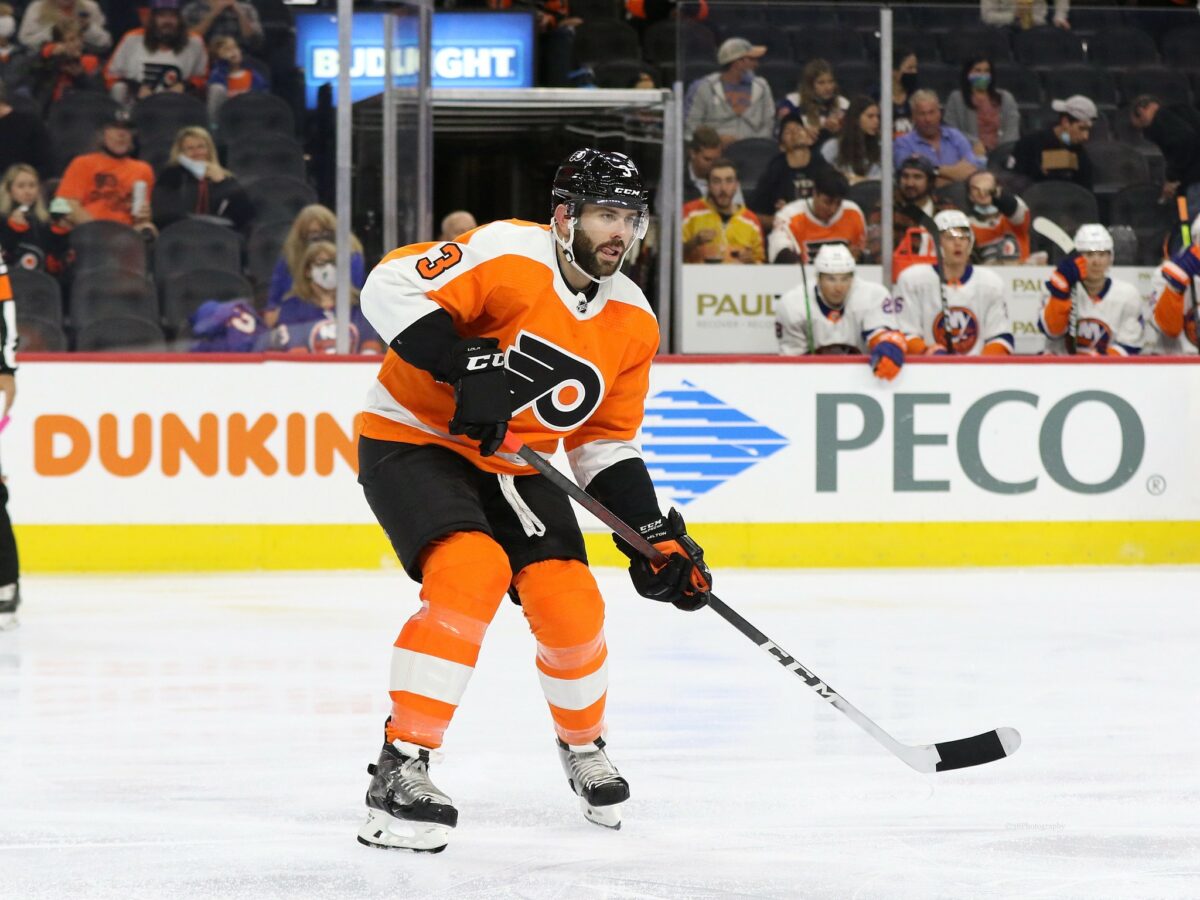The Philadelphia Flyers will begin the 2021-22 season with a revamped roster and something to prove following a disappointing finish last season. Offseason acquisitions like Keith Yandle and Ryan Ellis will join Sean Couturier and Claude Giroux as contributors on the power play this season. The Flyers ranked 18th in the NHL with the man advantage in 2020-21, converting at a 19.2 percent rate.
Flyers Power Play in Need of Change
The power play was a strength for Philadelphia when they finished sixth, third, eighth, and third, respectively, from 2011-12 through 2014-15. It has slipped into mediocrity throughout the past six seasons, and they finished outside the top 10 in each of Dave Hakstol’s first two seasons as head coach in 2015-16 and 2016-17. They moved on from former power-play coach Joe Mullen in 2017, but the slide continued, and they finished 15th and 23rd with the man advantage in the next two seasons.

Head coach Alain Vigneault began in Philadelphia ahead of the 2019-20 season, and he brought in Michel Therrien to work with the power-play unit. The Flyers have not shown drastic improvement in either of Therrien’s two seasons, finishing 14th and 18th on the PP in 2019-20 and 2020-21.
Their stale strategy with the man advantage contributed to some of the transactions made by general manager Chuck Fletcher during the 2021 offseason. The Flyers traded Jakub Voracek, a staple on the power play over the past decade, and Shayne Gostisbehere, who tied for the team lead in average power-play time per game last season. The top unit regularly counted on Voracek’s distribution from along the boards on the right side and Gostisbehere’s strong shot as the lone defenseman at the top of the zone in recent years.
Related: Flyers Hopes to Improve Penalty Kill in 2021-22
Fletcher also moved Nolan Patrick, who received considerable ice time on the second power-play unit in 2020-21. Vigneault attempted to kickstart the former second-overall pick with opportunities to rack up points and build confidence, but Patrick finished with only three power-play points all season.
Fletcher Acquires Power-Play Help
Keith Yandle signed with Philadelphia on a one-year contract in July. The 15-year veteran led the NHL in power-play minutes last season. A remarkable 244 of his 498 career assists have come with the man advantage. He will take over for Gostisbehere as the lone blueliner on the top unit, but Therrien will expect him to play a different style. He won’t boast the same blast from the point, but his experience as a puck-mover and a playmaker will bring a new element.

The Flyers will begin the season with Giroux, Couturier, and Travis Konecny on the top line and the top power-play unit. Giroux has never been a tremendous goal-scorer at even strength, but he displays an effective shot in addition to his playmaking ability on the power play. He will likely play the majority of his PP time at the top of the left circle. James van Riemsdyk will round out the first unit, using his 6-foot-3, 217-pound frame in tightly contested areas around the goal crease.
The Flyers leaned on Joel Farabee with the man advantage during the preseason. He showcased an excellent long-range shot and scored two power-play goals (PPG) on Sept. 30 against the Boston Bruins. He slid into Giroux’s spot on the left circle while the long-time captain sat out during their second matchup with Boston the following week.
Related: Philadelphia Flyers 2021-22 Season Preview Section
Ryan Ellis and Ivan Provorov will be the team’s top defensive pair to begin the season. The tandem will work together on the blue line for the second power-play unit. Newly acquired Cam Atkinson will likely play up front on the second unit. He will bring an aggressive shooter’s mentality that the Flyers have lacked at times in the past. Derick Brassard might get opportunities early in the season also.
Flyers Showing Encouraging Signs of Change
The reception from Vigneault and the team was positive concerning the new-look power play during the preseason. As pointed out by Charlie O’Connor, the power play was “utilizing more motion and set plays than in past years and buzzing even on shifts when they fail to score” (from The Athletic, “To worry, or not to worry — with Flyers’ preseason slate at an end, which concerns are legitimate?”, 10/8/21).
As discussed during a recent episode of the Flyers Daily podcast, the team benefits from a sense of momentum if a power play produces good pressure without scoring. The opposite scenario played out during the 2020 Stanley Cup Playoffs when the Flyers went 4/52 with the man advantage in the Toronto bubble. Their struggles reached a point during their Eastern Conference Semifinal series when the man advantage became a way to shift momentum in favor of the New York Islanders because of their ability to stifle the Flyers’ attack.
Philadelphia hopes to rejoin the upper echelon of the Metropolitan Division and the NHL in 2021-22. Their division will be filled with prolific power-play scoring. The Carolina Hurricanes, Washington Capitals, and Pittsburgh Penguins ranked second, third and fourth in the NHL, respectively, on the power play last season. The Flyers will need to match the characteristics of their competition if they hope to take advantage of opponents’ mistakes and capitalize with a dangerous power play.